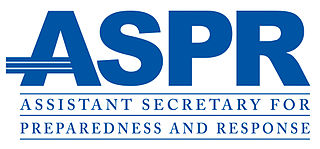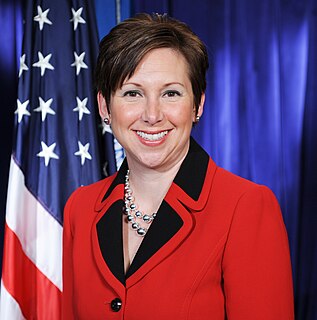Related Research Articles

The Federal Emergency Management Agency (FEMA) is an agency of the United States Department of Homeland Security, initially created under President Jimmy Carter by Presidential Reorganization Plan No. 3 of 1978 and implemented by two Executive Orders on April 1, 1979. The agency's primary purpose is to coordinate the response to a disaster that has occurred in the United States and that overwhelms the resources of local and state authorities. The governor of the state in which the disaster occurs must declare a state of emergency and formally request from the President that FEMA and the federal government respond to the disaster. The only exception to the state's gubernatorial declaration requirement occurs when an emergency or disaster takes place on federal property or to a federal asset—for example, the 1995 bombing of the Alfred P. Murrah Federal Building in Oklahoma City, Oklahoma, or the Space Shuttle Columbia in the 2003 return-flight disaster.

Emergency management is the organization and management of the resources and responsibilities for dealing with all humanitarian aspects of emergencies. The aim is to reduce the harmful effects of all hazards, including disasters...

Criticism of the government response to Hurricane Katrina consisted primarily of condemnations of mismanagement and lack of preparation in the relief effort in response to Hurricane Katrina and its aftermath. Specifically, there was a delayed response to the flooding of New Orleans, Louisiana.

This article contains a historical timeline of the events of Hurricane Katrina on August 23–30, 2005 and its aftermath.

The Robert T. Stafford Disaster Relief and Emergency Assistance Act is a 1988 United States federal law designed to bring an orderly and systematic means of federal natural disaster assistance for state and local governments in carrying out their responsibilities to aid citizens. Congress' intention was to encourage states and localities to develop comprehensive disaster preparedness plans, prepare for better intergovernmental coordination in the face of a disaster, encourage the use of insurance coverage, and provide federal assistance programs for losses due to a disaster.

Robert David Paulison is an American former fire chief who served as the director of the Federal Emergency Management Agency (FEMA). Paulison was appointed by President George W. Bush on September 12, 2005 to replace the embattled Michael D. Brown, who resigned amid controversy over his handling of disaster relief in the aftermath of Hurricane Katrina. Prior to his appointment, Paulison was perhaps best known nationally for his 2003 advisory regarding household items to have on hand in case of terrorist attack. At the 2009 National Hurricane Conference, he announced he would resign January 21, 2009.
Saint Lucia's National Emergency Management Organisation (NEMO) is responsible for disaster preparedness and disaster response co-ordination.

The National Disaster Medical System (NDMS) is a federally coordinated healthcare system and partnership of the United States Departments of Health and Human Services (HHS), Homeland Security (DHS), Defense (DOD), and Veterans Affairs (VA). The purpose of the NDMS is to support State, local, Tribal and Territorial authorities following disasters and emergencies by supplementing health and medical systems and response capabilities. NDMS would also support the military and the Department of Veterans Affairs health care systems in caring for combat casualties, should requirements exceed their capacity.
The Massachusetts Emergency Management Agency (MEMA) is a Commonwealth of Massachusetts agency. The Massachusetts Emergency Management Agency is the Agency that coordinates federal, state, local, and private resources throughout the Commonwealth during times of disasters and emergencies.

The Emergency Management Institute (EMI) of the United States Federal Emergency Management Agency serves as the national focal point for the development and delivery of emergency management training to enhance the capabilities of state, territorial, local, and tribal government officials; volunteer organizations; FEMA's disaster workforce; other Federal agencies; and the public and private sectors to minimize the impact of disasters and emergencies on the American public. EMI curricula are structured to meet the needs of this diverse audience with an emphasis on separate organizations working together in all-hazards emergencies to save lives and protect property. Particular emphasis is placed on governing doctrine such as the National Response Framework (NRF), National Incident Management System (NIMS), and the National Preparedness Guidelines. EMI is fully accredited by the International Association for Continuing Education and Training (IACET) and the American Council on Education (ACE). The instruction is based upon the principles of Emergency Management and instructional systems design, which create a framework within whole communities to reduce vulnerability to hazards and to cope with disasters. EMI develops courses and implements training delivery systems to include residential onsite training; offsite delivery in partnership with Emergency Management training systems, colleges, and universities; and technology-based mediums to conduct individual training courses for Emergency Management and Response personnel across the United States.
The United States National Response Framework (NRF) is part of the National Strategy for Homeland Security that presents the guiding principles enabling all levels of domestic response partners to prepare for and provide a unified national response to disasters and emergencies. Building on the existing National Incident Management System (NIMS) as well as Incident Command System (ICS) standardization, the NRF's coordinating structures are always in effect for implementation at any level and at any time for local, state, and national emergency or disaster response.

The Office of the Assistant Secretary for Preparedness and Response (ASPR) within the United States Department of Health and Human Services was created under the Pandemic and All Hazards Preparedness Act in the wake of Hurricane Katrina to lead the nation in preventing, preparing for, and responding to the adverse health effects of public health emergencies and disasters. ASPR focuses on preparedness planning and response; building federal emergency medical operational capabilities; countermeasures research, advance development, and procurement; and grants to strengthen the capabilities of hospitals and health care systems in public health emergencies and medical disasters. The office provides federal support, including medical professionals through ASPR’s National Disaster Medical System, to augment state and local capabilities during an emergency or disaster.

On December 19, 2006, the Pandemic and All-Hazards Preparedness Act (PAHPA), Public Law No. 109-417, was signed into law by President George W. Bush. First introduced in the House by Rep. Mike Rogers (R-MI) and Rep. Anna Eshoo (D-CA), PAHPA had broad implications for the United States Department of Health and Human Services's (HHS) preparedness and response activities. Among other things, the act amended the Public Health Service Act to establish within the department a new Assistant Secretary for Preparedness and Response (ASPR); provided new authorities for a number of programs, including the advanced development and acquisitions of medical countermeasures; and called for the establishment of a quadrennial National Health Security Strategy.
The California Governor's Office of Emergency Services is a California cabinet-level agency responsible for overseeing and coordinating emergency preparedness, response, recovery and homeland security activities within the state. The agency was created by AB 38 (2008), superseding both the Office of Emergency Services (OES) and Office of Homeland Security (OHS).
The Stephenson Disaster Management Institute at Louisiana State University is located in the Stephenson National Center for Security Research and Training at LSU.

Elizabeth M. Harman is employed by the International Association of Fire Fighters (IAFF) in Washington, D.C. She was appointed by IAFF General President Harold A. Schaitberger as the assistant to the general president for grants administration and HazMat/WMD Training Division February 25, 2013.
In September 2011, Federal Emergency Management Agency (FEMA) released the National Disaster Recovery Framework (NDRF), which serves as a companion document to the National Response Framework (NRF). The NDRF is a guide to promote effective recovery, particularly for those incidents that are large-scale or catastrophic. Similar to how the NRF is the overarching interagency response coordination structure for both Stafford Disaster Relief and Emergency Assistance Act and non-Stafford Act incidents, the NDRF will provide the overarching inter-agency coordination structure for the recovery phase for Stafford Act incidents, and elements of the framework may also be used for significant non-Stafford Act incidents.

National Response Scenario Number One is the United States federal government's planned response to a nuclear attack. It is one of the National Response Scenarios developed by the United States Department of Homeland Security, considered the most likely of fifteen emergency scenarios to impact the United States. The Scenarios are related to the National Response Framework (NRF), which describes the structures and mechanisms of a response and the National Incident Management System (NIMS) that gives a framework to orchestrate emergency management.
The National Domestic Preparedness Consortium (NDPC) is a training partner and established training arm of the U.S. Department of Homeland Security DHS/ FEMA. It is a professional alliance of seven national institutions and organizations that work to develop and deliver training, technical assistance, plan assessments, and exercises to emergency responders and first receivers at the territories, state, local and tribal levels. The members were chosen for their unique knowledge bases in the areas of chemical, biological, radiological, nuclear, explosive, medical, critical infrastructure, and incident management, and have enhanced their core competencies at the request of DHS and FEMA to include other areas as well. The following is a list of the NDPC members and their core competencies:

The Promoting Resilience and Efficiency in Preparing for Attacks and Responding to Emergencies Act, or PREPARE Act, of 2017 is a bill introduced in the United States House of Representatives by U.S. Representative Dan Donovan. The bill would assist American attempts to protect the nation from potential terror attacks and fortify emergency response capabilities through reauthorizing grants for programs that are necessary for disaster relief.
References
- ↑ National Response Plan in PDF Format Archived February 10, 2009, at the Wayback Machine
- ↑ FEMA Home page
- ↑ Federal Response Plan, 1999
- ↑ EPA: Oil Spills
- ↑ Federal Radiological Emergency Response Plan (FRERP)--Operational Plan
- ↑ Guide for All Hazards Emergency Operations Planning
- ↑ Baca, Anna. "History of Disaster Legislation" (PDF). Federal Emergency Management Agency. Retrieved March 30, 2021.
- ↑ DHS | Preparedness & Response Archived July 9, 2009, at the Wayback Machine
- ↑ Draft National Response Framework Released for Public Comment, September 10, 2007, archived from the original on January 9, 2008, retrieved January 4, 2008
- ↑ "National Response Framework | FEMA.gov". www.fema.gov. Retrieved December 1, 2015.